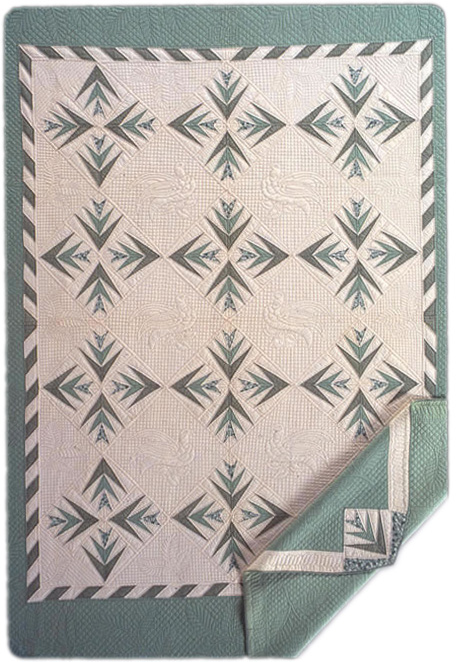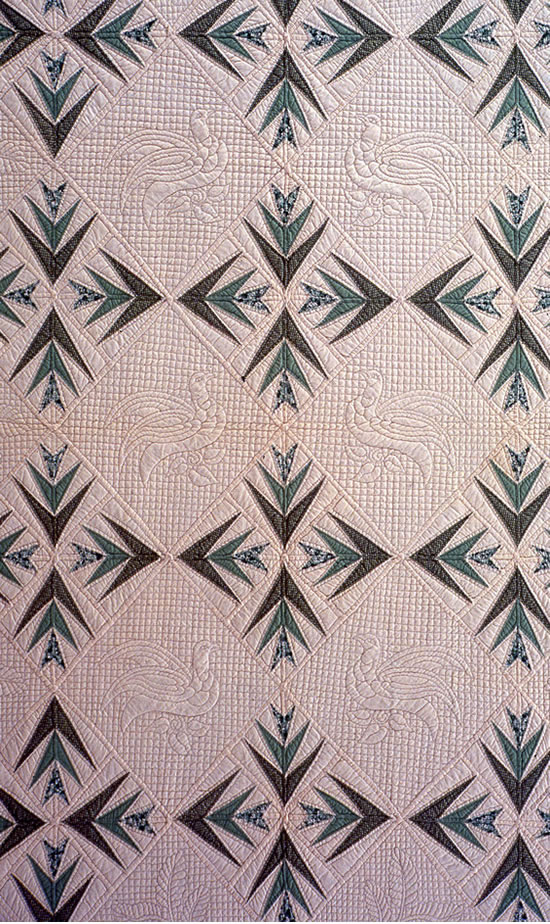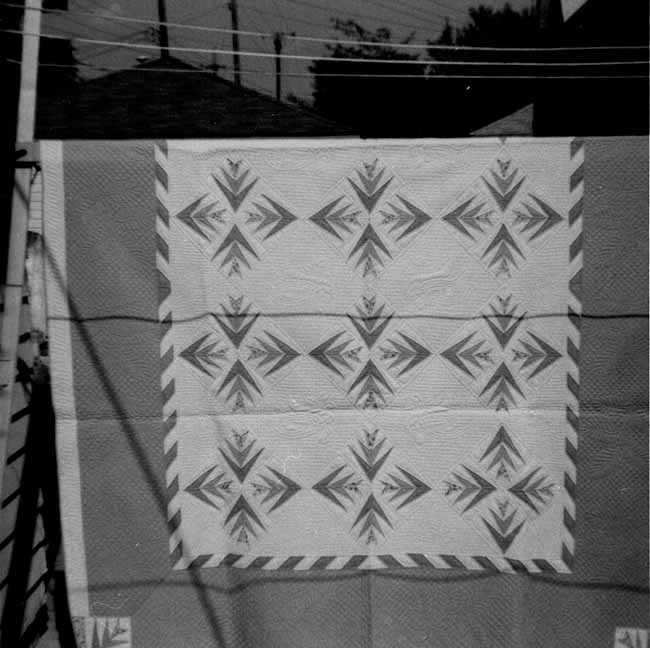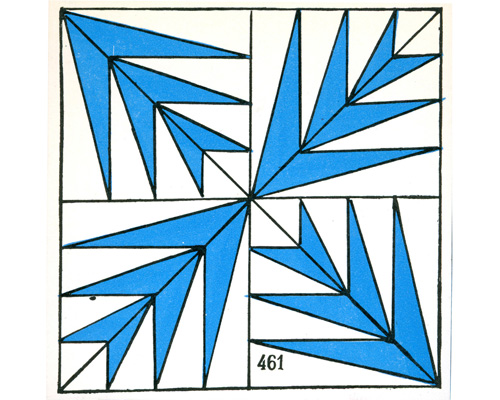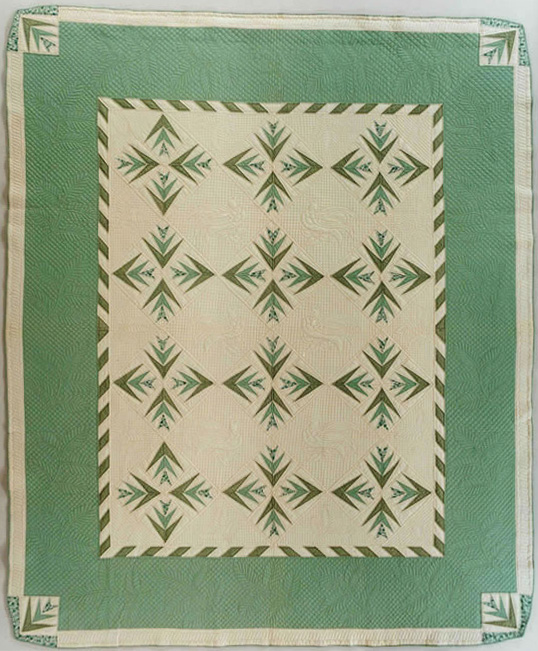
QUILT INDEX RECORD
18-14-87
Description:
Gasperik created a pieced quilt based on a traditional pattern block, which she might have found in a number of publications at the time. The alternating plain blocks and the wide green border provided areas for her favored quilting motifs--the Dove of Peace and the Fern Leaf designs. It is likely Gasperik undertook this particular quilt project when Bertha Stenge’s Palm Leaf quilt won national acclaim in “America Through the Needle’s Eye,” a contest held in connection with the 1939-40 New York World’s Fair and sponsored by Macy’s. It won the $500 Grand Prize and tied for the $125 Most Popular prize. Gasperik had entered ‘Road to Recovery’ (#066) in a different New York World’s Fair quilt contest (sponsored by Good Housekeeping). That Gasperik quilt (which was an original design) won no prize and was sent back rather than displayed with other quilts made for the fair. Gasperik probably deliberately set about to make her own Palm Leaf quilt, taking the Stenge acclaim as a personal challenge.
Essay:
This pieced block was offered by the major quilt pattern sources in the 1930s, including:
Ladies Art Co. #461 (1920s) - "Palm Leaf";
Kansas City Star (McKim Studios) - "Palm Leaf";
Ruby McKim's 101 Patchwork Patterns - "Palm Leaf" (1930s);
Quilting booklet by Alice Beyer (1934);
Nancy Cabot in Chicago Tribune (1930s);
Laura Wheeler #1370 - "Palm" (1930s)
Home Art Studios - Pattern #191 - "Hosanna Quilt" (1930s);
Hall & Kretsinger Romance of the Patchwork Quilt pp. 102-103 - "Hozanna" or "The Palm" (1935);
Mountain Mist #77 - "The Palms" copyright 1940.
Chicago quilter Bertha Stenge created a similar quilt using this same block. She won several state and local contests with her Palm Leaf quilt in 1935 and 1936. She added trapunto designs, which attracted the judges' notice. In the summer of 1940, Stenge won the 1940 New York World's Fair contest with her Palm Leaf quilt. Gasperik probably saw Stenge's quilt when it was exhibited in Chicago in 1936. According to the April 20, 1936 Chicago Tribune, 65,000 persons visited the pageant during its first two days. Stenge's Palm Leaf quilt was the pageant's "first prize loan exhibit quilt, the most valuable at the Women's Pageant of Progress on Navy pier." Stenge's quilt featured pairs of quilted birds. It is interesting that Gasperik chose to quilt pairs of birds into her Hosannah quilt, made years after the Stenge quilt, showing that she desired to make something similar; but Gasperik did not add trapunto as Stenge did.
Where are the records for this quilt housed?
Mary Gasperik Legacy Project
Who documented this quilt?
Mary Gasperik Private Collection
Gasperik Legacy Project Number:
020
This is a:
Finished quilt
Quilt's title:
Hosannah
Owner's name for quilt:
Hosannah
Names for quilt's pattern in common use:
Palm Leaf
Brackman # or other source & #:
1304.5
How wide is the quilt?
75 inches
How long is the quilt?
91 inches
Shape of edge:
Other
Describe the edge:
Corners are slightly, and deliberately, shaved.
Shape of corners:
Straight
What color is the quilt?
Cream; Green
Antique colors:
Nile Green
Overall color scheme:
Light or pastel colors
Quilt's condition:
Excellent/like new
Type of inscription:
Date; Place
What is inscribed on the quilt?
"1941" and "CHICAGO" in Japanese style lettering.
What is the date inscribed on the quilt?
1941
Method used to make the inscription:
In the quilting
Location of inscription:
other
Describe where the inscription was found:
Top - Front of Quilt
Time period:
1930-1949
When was the quilt finished?
1941
Family/owner's date for quilt:
1941
Date estimated by an antique dealer, quilt historian or appraiser:
1941
Who estimated the quilt's date?
Merikay Waldvogel
Further information concerning dates:
Based on pattern source, Nile green color, etc.
Describe the quilt's layout:
Block pattern
Number of quilt blocks:
12
Arrangement of quilt blocks:
On point or rotated on 45 degrees
Spacing of quilt blocks:
Alternating with plain squares
Number of different block patterns used in the quilt:
1
What is the shape of the quilt blocks?
Same block throughout
Number of borders:
3
Describe the borders:
Pieced diamond border surrounds center panel; then a wide green border; and finally a narrow white border. The border corners are inset palm leaf blocks edged with slightly triangular pieces probably chosen to echo the leaf shape. These create the unusual effect of a shaved corner.
Fiber types used to make the quilt top:
Cotton
Fabric styles used in the quilt top:
Print; Solid/plain
Materials used to make the back:
Cotton
What color is the back of the quilt?
Green
Describe the back:
Same fabric used throughout; Solid/plain
Materials used in the quilt binding:
Cotton
What is the width of the binding (measure on the top only)?
less than a half inch
How are the layers held together?
Hand quilting
Color of thread used in the quilting:
white
Can you see any knots on the front or back of the quilt?
no
Quilting designs used, overall motifs:
Grid diamond; Grid square
Quilting designs used, decorative motifs:
Other
Quilting designs used, background fills:
Grid/crosshatch
Describe the quilting designs used:
Dove of Peace was possibly copied from Carrie Hall Plate XII facing page 75 of Hall and Kretsinger Romance of the Patchwork Quilt in America in plain blocks. Another source, closely resembling the Carrie Hall block was offered on page 6 of the 1933 booklet Sears Century of Progress in Quilt Making as Perforated Quilting Pattern 25A47250. The quintuplet fern leaf motif in green border and triplet fern leaf in half triangle blocks in center panel (from Aunt Martha commercial pattern). It should be noted that Sears Century of Progress in Quilt Making also advertised "Perforated Quilting Pattern 25A47201" described as "The beautiful feathered design" which appeared on the Grand Prize Winning quilt submitted to the Sears Quilt Contest by Margaret Rogers Caden of Kentucky. Absent being able to compare either of these actual quiltING patterns with the many Gasperik quilts on which this design is quilted, it is impossible to know for sure what Mary Gasperik's original source was for what turned out to be her favorite quiltING motif!
Features or notes about the quilt's appearance, materials, or construction:
Unusually shaped (shaved) corners.
Quilt top made by:
Gasperik, Mary
Quilted by:
Gasperik, Mary
Where the quilt was made, city:
Chicago
Where the quilt was made, county:
Cook County
Where the quilt was made, state:
Illinois (IL)
Where the quilt was made, country:
United States
How was this quilt acquired?
Inheritance
Tell the story of how the quilt was obtained:
Hosannah was given to Doris and Elmer Gasperik and later inherited by their children.
Why was the quilt made?
Personal enjoyment
Details about why the quilt was made:
Perhaps made as a response to the acclaim for Bertha Stenge's grand prize-winning Palm Leaf quilt in the 1939-1940 national quilt contest America Through the Needles Eye.
The quilt was made to be used for:
Bedding, special occasion
Quilt is presently used as:
Keepsake/memento
Describe present uses of the quilt:
Mary's grandchildren regard her quilts as a unique collection to be preserved and appreciated.
Where did the maker get their materials?
Purchased new
Where did the maker find their pattern?
Commercial/Published source: Pattern; Other
Describe the source of the pattern:
Hosannah, page 15, in Quilting, a manual written for Chicago's Tuley Park Quilt Club.
Where did the quiltmaker find the pattern for the quilting design on the quilt?
Commercial pattern; Other
Describe where the quilting design pattern was found:
Dove of Peace pictured in Plate XII (facing page 75) of "Reproductions of Quilt Patches" by Carrie A. Hall in The Romance of the Patchwork Quilt in America by Carrie A. Hall and Rose G. Kretsinger (1935).
Lettering from The Wonder Package.
What is the commercial name of the quilting design used for this quilt?
Fern leaf quiltING pattern from Aunt Martha;
Dove of Peace quiltING probably copied from Carrie Hall, Plate XII.
Exhibitions where this quilt was displayed:
The existence of yellow paper exhibit slip reading Hosanna indicates this quilt was probably included in a Tuley Park quilt show.
The Quilts of Mary Gasperik, Ravenswood Historic Site, Livermore, CA, March 14-15, 1992.
This is one of the 23 Mary Gasperik quilts exhibited in the Carnegie Room of the Marion Indiana Public Library July 16-17, 2021 in connection with the ceremony honoring the induction of Mary Gasperik into The Quilters Hall of Fame as their 2021 Legacy Quilter honoree. Mary Gasperik Quilters Hall of Fame Induction Exhibit.
Publications (including web sites) where this quilt or maker was featured:
Merikay Waldvogel and Barbara Brackman. Patchwork Souvenirs of the 1933 Chicago World's Fair, (Nashville, TN: Rutledge Hill Press, 1993)102-103.
Merikay Waldvogel "One American Dream Comes True", Quilters Newsletter Magazine, March 2008, 46-49.
Related items such as diaries, obituaries, wills, household inventories, or pictures of the quiltmaker:
Quilting, by Alice Beyer, Director - Art Crafts for the Chicago Park District. Copyright 1934, South Park Commissioners, Chicago.
Information on Stenge quilt from Twentieth Century Quilts 1900-1950, by Thomas K. Woodard and Blanche Greenstein, E. P. Dutton, New York, 1988, page 24.
Bertha Stenge's grand-prize-winning Palm Leaf quilt featured "Love Birds" quilted into its top and its border (Quilters' Journal, Summer 1980, Vol. 3 No. 2, p. 15, in a quotation from American Home, Sept. 1947).
Ownership of this quilt is:
Private
Quilt owner's name:
Heirs of Elmer Gasperik - Kathy Jacob contact.
Quilt owner's country:
United States
Person filling out this form is:
Relative of quiltmaker; Author/researcher
If you are a relative of the quiltmaker, how are you related? The quiltmaker is my:
Grandmother
Describe the relationship to the quilt's maker:
Grand-daughter Susan Salser began this research effort in 1991, after she and her two sisters divided up the quilts which belonged to their mother (Elsie Gasperik Krueger) who died in 1988. Her ongoing research has been fruitful and interesting.
Quiltmaker's maiden name:
Mihalovits, Maria
Quiltmaker's gender:
Female
Quiltmaker's birth date:
01/25/1888
Quiltmaker's birthplace, country:
Hungary
Quiltmaker's marriage date(s):
11/18/1906
Quiltmaker's date of death:
05/25/1969
Quiltmaker's ethnic background/tribal affiliation:
Hungarian
Quiltmaker's educational background:
Elementary School
In which kind of environment did the quiltmaker live?
Rural
Quiltmaker's city:
Chicago
Quiltmaker's county:
Cook
Quiltmaker's state:
Illinois (IL)
Quiltmaker's country:
United States
Quiltmaker's father's name:
Mihalovits, Istvan
Quiltmaker's father's birthplace:
Hungary
Quiltmaker's father's ethnic/tribal background:
Hungarian
Quiltmaker's mother's name:
Mihalovits, Vidoszava
Quiltmaker's mother's birthplace:
Hungary
Quiltmaker's mother's ethnic/tribal background:
Hungarian
Quiltmaker's spouse's/spouses' and /or partner's/partners' name(s):
Gasperik, Stephen
Quiltmaker's spouse's/spouses' and/or partner's/partners' ethnic/tribal background:
Hungarian
Quiltmaker's spouse's/spouses' and/or partner's/partners' occupation:
Milk Dealer/Grocery Store Owner/Butcher
Number of children:
3
How many of the quiltmaker's children were girls?
1 (Elsie 1909-1988)
How many of the quiltmaker's children were boys?
2 (Elmer and Stephen)
How did the quiltmaker learn to quilt?
From guild or club member; Self-Taught
When did the quiltmaker learn to quilt?
Age 40-49
Why does the quiltmaker quilt?
Pleasure; Other
Other notes on how the quiltmaker learned, and how and why they quilt:
To exhibit in shows held by her Tuley Park quilt club in Chicago, the Detroit News quilt show in Detroit, many Illinois State Fairs, at least one Indiana State Fair. She entered quilts in at least 2 Chicago department store contests. She made at least one quilt and one quilt top specifically for the 1939 New York Worlds Fair quilt contest. She also made children's quilts specifically for grandchildren and great-grandchildren; and wedding and wedding anniversary quilts for her son Elmer and grand-daughter Karen. Primarily, she wanted to make quilts because it was her life passion and her greatest talent. The occasions and venues to show them presented themselves. It should be noted that prior to Mary's emigration to America in late 1904, at age 16, she was an apprenticed needleworker in her native Hungary. The intricate and colorful floral embroideries traditional to Hungary lend themselves especially well to applique, the quilt style Mary preferred.
Does/did the quiltmaker belong to a group? Name of the group?
Tuley Park Quilt Club and Detroit News Quilt Club
Does/did the quiltmaker belong to a group?
Southside Chicago and Detroit MI
What are the main activities of the group?
Chicago group met to quilt and held periodic quilt shows; Detroit group held national exhibits and contests.
Estimated number of quilts made by this quiltmaker:
more than 50
Does/did the quiltmaker sell quilts?
no
Does/did the quiltmaker teach quilting?
no
Who photographed this quilt?
Don Gonzalez
Access and copyright information:
Restricted
Copyright holder:
Susan Salser
Details
Cite this Quilt
Gasperik, Mar. Hosannah. 1941. From Mary Gasperik Legacy Project, Mary Gasperik Private Collection. Published in The Quilt Index, https://quiltindex.org/view/?type=fullrec&kid=18-14-87. Accessed: 04/23/24
-
Ephemera
Mountain Mist, The Palms or Hosanna, P...
Mountain Mist
-
Gallery
Understanding Quilt-Specific Colors: N...
Sikarskie, Amanda Grace
-
Gallery
Gasperik 03: 1930s Quilt Pattern Sourc...
Waldvogel, Merikay
-
Exhibit
The Quilts of Mary Gasperik
Salser, Susan
-
Ephemera
The Quilts of Mary Gasperik
Salser, Susan
-
Exhibit
Mary Gasperik Quilters Hall of Fame In...
Salser, Susan
-
Ephemera
Womenfolk 45. Palm Leaves, A Bible Blo...
Breneman, Judy Anne
-
Gasperik, Mary Quiltmaker
Mary Gasperik Legacy Project
